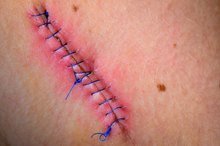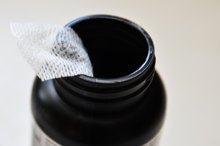What does fact checked mean?
At Healthfully, we strive to deliver objective content that is accurate and up-to-date. Our team periodically reviews articles in order to ensure content quality. The sources cited below consist of evidence from peer-reviewed journals, prominent medical organizations, academic associations, and government data.
The information contained on this site is for informational purposes only, and should not be used as a substitute for the advice of a professional health care provider. Please check with the appropriate physician regarding health questions and concerns. Although we strive to deliver accurate and up-to-date information, no guarantee to that effect is made.
How to Dry Out Wounds
When it comes to the care of minor wounds, two types of healing methods exist. The first method, known as moist wound healing, implements moist protective covers to promote healing 2. Moist healing prevents scabbing, instead promoting the regeneration of new skin cells utilizing the liquid that exudes from the wound 2. Dry wound healing leaves the wound open to the circulation of fresh air, which helps heal the wound and dry it out through the scabbing process.
Apply pressure to the wound using a clean piece of gauze to stop the initial bleeding. As blood continues to saturate the gauze, add a fresh piece on top of the original piece.
How to Make Cuts Heal Faster
Learn More
Continue to apply pressure for 20 to 30 minutes or until bleeding stops. Remove the gauze afterward and rinse the wound with cool water to remove dirt and debris.
Blot the wound dry with a clean, dry piece of gauze. Apply a thin layer of antibiotic ointment to the wounded area using a cotton ball.
How to Lance a Wound
Learn More
Cover the wound with a second clean, dry piece of gauze, secured with surgical adhesive tape. The dry gauze will collect any liquid that exudes from the wound, causing a scab to form.
Replace the dry gauze covering once a day. Keep the wound covered with the dry gauze until a scab begins to form, which should occur within one to two days.
Allow the wound to remain open to the air once the scab forms. All healing will occur under the scabbed-over skin.
Tips
Clean the skin around the wounded area with soapy water and a clean, soft cloth if dirt remains after rinsing. However, avoid getting the soap in the wound.
Warnings
Do not apply a wet dressing to the wound. A wet dressing will prevent the wound from drying out.
If the wound continues to bleed despite your best efforts to stop it, seek medical attention immediately.
A wound that appears red and inflamed after a few days also requires a physician’s check to ensure that it is not infected.
Related Articles
References
- Family Doctor.org: First Aid: Cuts, Scrapes and Stitches
- Elastoplast: Moist Wound Healing
- 3M Wound Resource Center. http://solutions.3m.co.uk/wps/portal/3M/en_GB/skin-care/wound-resource-centre/
- Mccaughan D, Sheard L, Cullum N, Dumville J, Chetter I. Patients' perceptions and experiences of living with a surgical wound healing by secondary intention: A qualitative study. Int J Nurs Stud. 2018;77:29-38. doi:10.1016/j.ijnurstu.2017.09.015
- Krafts KP. Tissue repair: The hidden drama. Organogenesis. 2010;6(4):225-33. doi:10.4161/org.6.4.12555
- Chetter IC, Oswald AV, Fletcher M, Dumville JC, Cullum NA. A survey of patients with surgical wounds healing by secondary intention; an assessment of prevalence, aetiology, duration and management. J Tissue Viability. 2017;26(2):103-107. doi:10.1016/j.jtv.2016.12.004
- Singh PK, Saxena N, Poddar D, et al. Comparative Study Of Wound Healing In Primary Versus Delayed Primary Closure In Contaminated Abdominal Surgery. Hellenic J Surg. 2016;88:314–320. doi:10.1007/s13126-016-0340-8
- Surgical Patient Education Program: Prepare for the Best Recovery. American College of Surgeons. 2018.
- Rushbrook JL, White G, Kidger L, Marsh P, Taggart TF. The antibacterial effect of 2-octyl cyanoacrylate (Dermabond®) skin adhesive. J Infect Prev. 2014;15(6):236-239. doi:10.1177/1757177414551562
- Lazar HL, Mccann J, Fitzgerald CA, Cabral HJ. Adhesive strips versus subcuticular suture for mediansternotomy wound closure. J Card Surg. 2011;26(4):344-7. doi:10.1111/j.1540-8191.2011.01257.x
- 3M Wound Resource Center.
Writer Bio
Jonae Fredericks started writing in 2007. She also has a background as a licensed cosmetologist and certified skin-care specialist. Jonae Fredericks is a certified paraeducator, presently working in the public education system.




